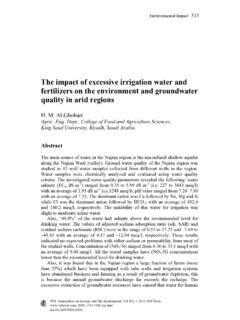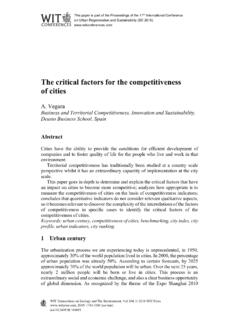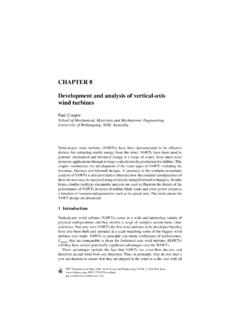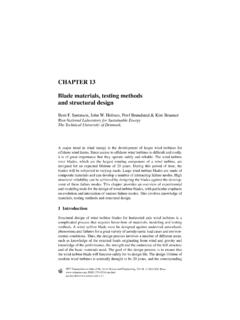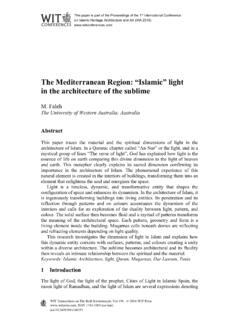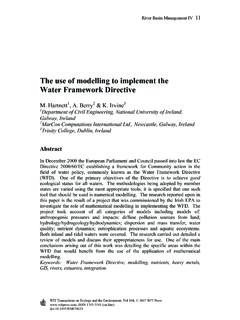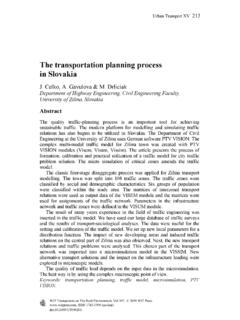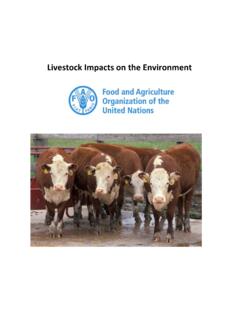Transcription of Tourism impact on coastal environment - WIT Press
1 Tourism impact on coastal environment S. Zahedi Allameh Tabataba'i University, Iran Abstract Tourism development in the coastal environment has interfaced with the original characteristics of the area upon which it relied for attracting tourists. An overall review of Tourism research on the environment shows that nations do not give priority to environmental sustainability and disregard it to the benefit of economic development. Rapid and uncontrolled Tourism development in the coastal zones has exposed their fragile ecosystems to an ever-increasing risk of environmental degradation. Tourism has also impacted on global warming through excessive energy use, transportation, water consumption, waste generation, etc. The impacts of Tourism have been sorted into four general categories, with more elaboration on the impacts of 3 Ss Tourism on coastal areas, followed by a few facts about the negative impacts of Tourism in different countries; the author presents a general framework for Tourism impact assessment in coastal environments.
2 The article ends with some suggestions in the hope of effective transition towards sustainable Tourism in coastal areas. Keywords: complex systems, 3 Ss Tourism , green productivity index, TIACA. 1 Introduction Tourism is the interrelated system that includes tourists and the associated services that are provided and utilized (facilities, attractions, transportation and accommodation) to aid in their movement [14, p. 2]. The prerequisites for Tourism are: attractiveness, facilities, accessibility of destination, ability to travel, and motivation [19, 27]. Tourism in coastal areas is one of the fastest growing types of the world Tourism industry, but whether it destroys more than it protects will depend upon how it is put into practice. Tourism development in the coastal environment has interfaced with the attractiveness of the destinations and has changed the original characteristics of the area upon which it relied for attracting tourists.
3 This means 2008 WIT PressWIT Transactions on The Built environment , Vol 99, , ISSN 1743-3509 (on-line) Environmental Problems in coastal Regions VII 45 Tourism in coastal regions, although it is ecologically based, it is not ecologically sound. An overall review of Tourism research on environment shows that nations do not give priority to environmental sustainability and disregard environmental protection to the benefit of economic development. As a matter of fact, all three sectors of the society: government, private and social sectors, are working to the detriment of the environment . According to Higham, the Tourism industry has done little more than pay lip service to the objective of sustainable development, notwithstanding the rhetoric of sustainable development; economic viability is the bottom line of sustainable Tourism operations [18, p. 7]. 2 Tourism research on environment Tourism research on ecological impacts started during the 1960s and 1970s.
4 Concerns over environmental issues in the realm of Tourism studies, according to Fennell, gained a tremendous boost in the mid 1970s from the efforts of Budowski [2], Krippendorf [25] and Cohen [6] in their work on Tourism and the environment . Budowski identified three different 'states' in Tourism 's relationship with environmental conservation: conflict, coexistence and symbiosis. He felt that the relationship at the time was one of coexistence moving towards conflict. Krippendorf was one of the first to write on the importance of planning, and the dispersion of tourists and Tourism developments, as a means by which to minimize impacts [14, p. 63]. Cohen discussed the distinct differences between development for purposes of improvement and aesthetic appeal versus the vulgar, undesirable, and irreparable damage created by modern Tourism [14]. Tourism research on ecological impacts continued throughout 1980s and since then concern over environmental impacts of Tourism has increased.
5 Many researchers emphasized on evaluating the impacts of Tourism on environment among which, Pearce [33], offered a framework for the study of Tourism and environmental stress. In his framework, he included stressor activities, the pressure resulting from the activity, the primary environmental response, and the secondary human response or reaction of the stress [33]. Others have identified a whole range of different Tourism impacts on environment , their sources, and regions in which these take place. The authors note that sources of impacts cited in the literature include trampling (vegetation, microbes, soils) access roads and trails, built facilities and camp grounds (camp sites and firewood), water edges (river banks, lakes and reservoirs, coastal areas and coral reefs). Although up until now, a considerable amount of research has been emphasized on the impacts of Tourism on the environment , the author believes that gathering exact data on environmental impacts of Tourism is rather difficult because the actual impacts of Tourism on the environment will only become apparent over a longer period of time.
6 Of course, this limitation should not be used as an excuse to avoid evaluation of Tourism activities on the environment . In order to overcome this limitation, academics, with the cooperation of practitioners, should conduct new research on this issue by employing a multi-disciplinary approach to conceive environmental impacts from different angles, with a system perspective. 2008 WIT PressWIT Transactions on The Built environment , Vol 99, , ISSN 1743-3509 (on-line) 46 Environmental Problems in coastal Regions VII3 Tourism excessive development Rapid and uncontrolled Tourism development in coastal areas has exposed their fragile ecosystems to an ever-increasing risk of environmental degradation. Ecosystems are the complex interconnections of plants, animals, and physical and chemical factors that make up the natural environments [24, p. 195]. Over-crowding, poor sewage disposal, boat-generated waste, beach erosion, over-fishing, and destruction of wildlife habitats have been reported as some of the negative consequences of excessive Tourism development in the coastal areas.
7 These detrimental activities will have impacts on the attractiveness of the raw materials of Tourism in these areas. They would also degrade the sensitive ecosystem and threaten the environmental quality of the area for the next generations. Tourism has also impacted on global warming through excessive energy use, transportation, water consumption, solid and liquid waste generation etc. There is a link between temperature and the related phenomena of cloud cover, wind patterns and velocity, rainfall and snow cover and these in turn relate to both terrestrial and marine environments [8, p. 353]. Figure 1: Climate change and Tourism . The results of climate research show that man has intensified the greenhouse effect by increasing the concentration of carbon dioxide in the earth's atmosphere which is accompanied by a rise in global average temperature, the rise of sea level and changes in vegetation [27, p.]
8 285]. This geological change will have an TERRESTRIAL environment Skiing/ Snowboarding/ Walking/ Climbing/ Touring Diving/ Swimming/ Sailing/ Fishing/ Sun-Bathing MARINE environment Cloud cover Rainfall Wind pattern & Velocity Snow cover Temperature 2008 WIT PressWIT Transactions on The Built environment , Vol 99, , ISSN 1743-3509 (on-line) Environmental Problems in coastal Regions VII 47impact on the attractiveness of the environment and may decrease the Tourism demand in the area. If we are to manage Tourism development in a sustainable way we need to have a better understanding of its positive and negative impacts on destinations. 4 Tourism impacts The impacts of Tourism can be sorted into four general categories: economic, political, social and cultural, and environmental impacts.
9 Each category includes positive and negative impacts. In order to move towards sustainability, community and Tourism leaders must try to maximize the positive impacts and to minimize the negative impacts of Tourism in the host community. The following are some of the Tourism impacts which are most cited in the literature [3, 4, 9, 17, 20, 22]. Economic impacts Some of the positive economic impacts of Tourism are: increasing employment opportunities, generating income, spending more on infrastructure and public utilities, raising the standards of living and improving the local economy. Among the negative impacts are: inflationary impacts of Tourism expenditures, increase in the price of goods and services, land and housing, and cost of living, increase in health-care, police and fire protection, increase potential for imported labor, increase cost for additional infrastructure ( water, sewer, power, fuel.)
10 Political impacts Tourism development has some positive political impacts such as reducing political unrest due to unemployment, increasing the level of security in the community, raising mutual esteem and understanding among different nations. Some of the negative political impacts of Tourism are: using Tourism as a means towards political purposes, kidnapping tourists, increasing the possibility of political riots among oppositions to government. Social and cultural impacts Tourism provides opportunities for meeting different people, exchanging ideas and promoting cultural values and beliefs. This might promote mutual recognition among nations and increase tolerance of cultural differences. Tourism can increase availability of recreation facilities, increase welfare and the quality of local people's life and promote a higher level of psychological satisfaction through interaction with other travelers [4, p.]
